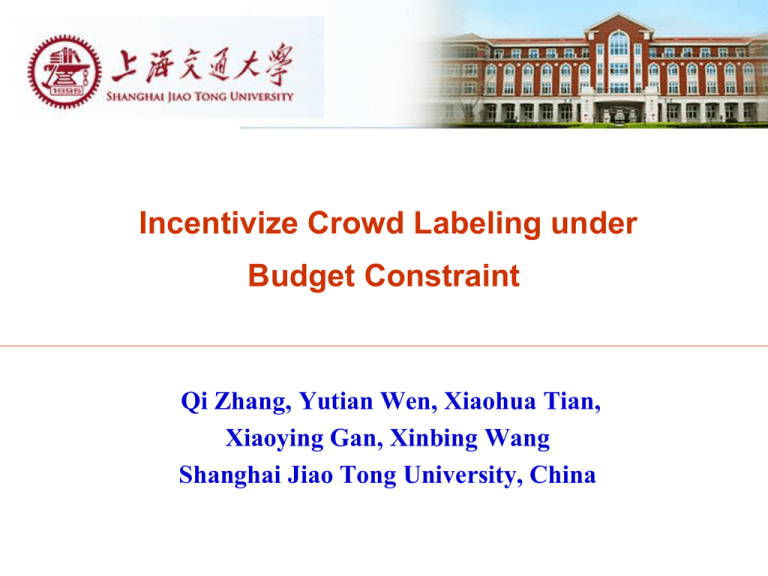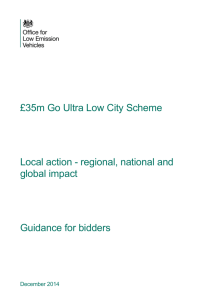Slides PPT
advertisement

Incentivize Crowd Labeling under
Budget Constraint
Qi Zhang, Yutian Wen, Xiaohua Tian,
Xiaoying Gan, Xinbing Wang
Shanghai Jiao Tong University, China
Outline
Introduction to Crowdsourcing Mechanism
Problem Formulation and Mechanism Setting
Mechanism Analysis
Performance Evaluation
2
Background
Crowdsourcing systems leverage human wisdom to
perform tasks, such as:
Image classification
Character recognition
Data collection
3
Types of Tasks
Tasks can be divided into two categories:
Structured response format
Binary choice
Multiple choice
Real Value
Unstructured response format
Logo design
4
Motivating Example
Example: Image classification
Workers
Dog
Task
Dog
Cat
Allocation
Crowdsourcing
Platform
Inference
Algorithm
Dog
Cat
Dog
5
Framework: Reverse Auction
(1)Tasks
(2)Bids
(3)Winning bids determination
(4)Winning bids
(5)Answers
(6)Payments
6
Major Challenges(1)
To design a successful crowdsourcing system
Task Allocation (winning bids)
• Tasks should be allocated evenly
Payment Determination:
• Must provide proper incentives (monetary rewards)
Inference Algorithm:
• Should improve overall accuracy
• Should address the diversity of the crowd
7
Major Challenges(2)
We need to model on
Diverse task difficulty
• Dog or Cat
• Older than 30 or Not
Diverse worker quality
Cat
8
Model on Tasks(1)
We focus on binary choice tasks
Each task is a 0 – 1 question
(Assumption) Each worker is uniformly reliable
Task
Soft Label
• Probability that the task is labeled as 1( by a reliable worker)
Crowd Label
0 or 1
9
Model on Tasks(2)
The soft label is viewed as a random variable
drawn from Beta distribution
Prior Parameters
Update parameters (a,b) by Bayes rule
Posterior
Inference
Prior
Likelihood
The task is inferred as 1
More than half agree
10
Framework: Reverse Auction
The platform publicizes a set of binary tasks
Workers reply with a set
of bids
• Each bid is a task-price pair
(Allocation) The platform sequentially decide winning bids
(Payment) Winning workers provide labels and get payment
11
Crowdsourcing Platform Utility
After observing all crowd labels
updated as
, the distribution is
Platform Utility: KL Divergence between
the initial and the final distribution
12
Problem Formulation
We want:
Platform utility maximization under budget constraint
Individual rationality
Truthful about the cost
Truthful bid
Untruthful bid
Computation Efficiency
13
Allocation Scheme (1)
The task allocation(winning bid determination) is sequential :
Candidate selection
•
one candidate a round
Candidate
Remaining bids
Proportional rule check
Discard
Winning bid
Answer collection & Soft label update
The allocation scheme repeats the 3 steps until
All bids
Discard
Winning bids
14
Allocation Scheme (2)
The candidate selection is greedy
• The largest platform utility gain per unit price
PU Gain
Candidate
Price
• Platform utility gain:
Current distribution
Updated distribution
15
Allocation Scheme (3)
Proportional rule check
budget
price
fraction ratio
Soft label update
•
Collect the answer from the winning bid
•
Update the soft label according to Bayes rule
16
Allocation Scheme (5)
Candidate selection
Proportional rule check
Soft label update
Computationally efficient !
17
Payment Scheme(1)
Winning bids
Discard
{A, B, C}
{D, E, F}
Kick out C
{ A,B,D,E,F }
Winning bids
{A,
B,
b2
b1
C
D,
b3
Discard
{F}
E}
b4
b1 is the minimum price
that bid C can replace bid A
p(C) = max {b1,b2, b3, b4}
18
Payment Scheme(2)
(Proposition)The winning bid C is paid threshold payment.
p(C)
C’s payment, b(C)
C’s bid
if b(C) < p(C), C is a winning bid
if b(C) > p(C), C is discarded
Winning bids
{A,
B,
b2
b1
D,
b3
E}
b4
C
p(C)=max { b1, b2, b3, b4}
19
Payment Scheme(3)
(Proposition)The incentive mechanism is truthful
Each bid
Workers will truthfully reveal the cost as asked price
has a cost
Why?
Proof:
Threshold payment + Greedy candidate Selection
20
Individual Rationality
(Proposition)The incentive mechanism is individual rational
The utility of a winning bid is nonnegative
Proof: Let us consider the winning bid C
1.
C is the 3rd winning bid.
2.
The first 2 bids are the same
3.
b3 is the minimum price
that bid C can replace the new
New Winning bids
{A,
3rd
bid (D)
b1
B,
b2
D,
b3
E}
b4
It is true that b3 > b(c) !
p(C) = max {b1, b2, b3, b4}, p(C) > b3
{ A, B, C}
Original wining bids
p(C) > b(C)
21
Budget Feasibility
(Proposition, Payment Bound) Payment to each winning bid
is upper bounded by
•
Proportional rule:
•
Set
22
Performance Evaluation(1)
Benchmark
1.
Untruthful Allocation: Workers’ cost is public information
2.
Random Allocation: Candidate selection is random
Truthful
Benchmark 1
Benchmark 2
My Mechanism
Running
Time
Platform
Utility
High
Low
Low
High
23
Performance Evaluation(2)
Metric 1 : Platform Utility
•
Platform utility vs. Budget
Price of Truthfulness
Gain over random allocation
24
Performance Evaluation(3)
Metric 2 : Budget Utilization
•
Payment / Budget
Budget utilization gain
Over random allocation
25
Thank you !
Presented by : Qi Zhang





